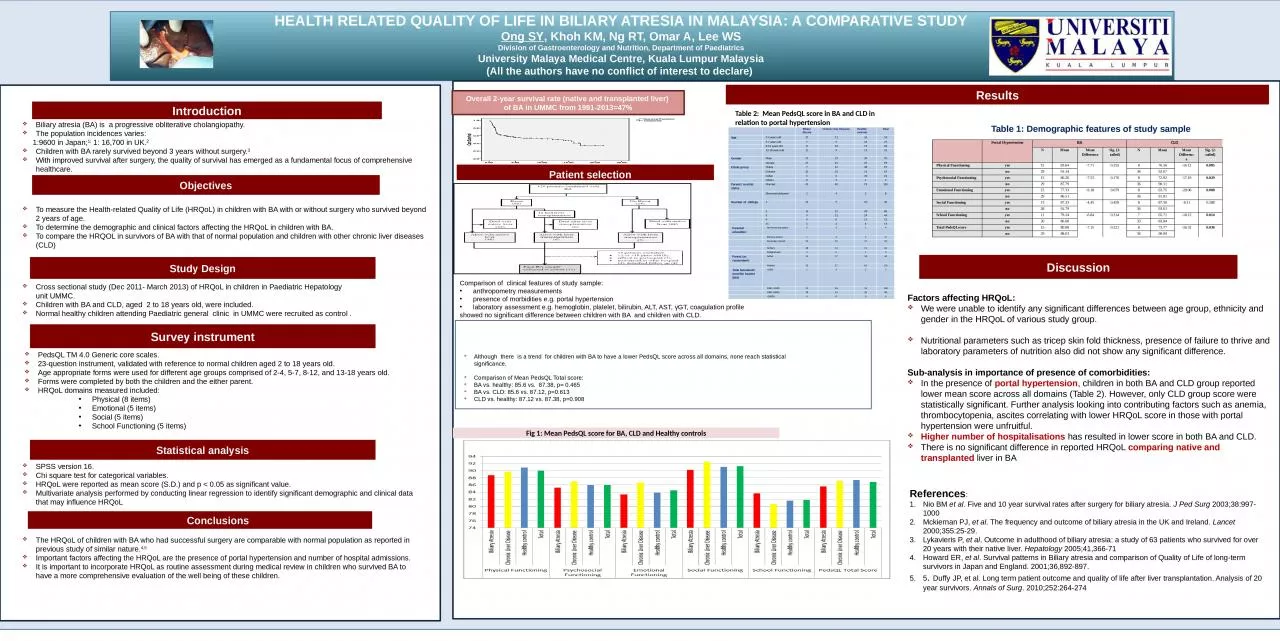

Ong SY Khoh KM Ng RT Omar A Lee WS Division of Gastroenterology and Nutrition Department of Paediatrics University Malaya Medical Centre Kuala Lumpur Malaysia All the authors have no conflict of interest to declare ID: 1038425
Download Presentation The PPT/PDF document "Health Related Quality of Life in Biliar..." is the property of its rightful owner. Permission is granted to download and print the materials on this web site for personal, non-commercial use only, and to display it on your personal computer provided you do not modify the materials and that you retain all copyright notices contained in the materials. By downloading content from our website, you accept the terms of this agreement.
1. Health Related Quality of Life in Biliary Atresia in Malaysia: A comparative studyOng SY, Khoh KM, Ng RT, Omar A, Lee WSDivision of Gastroenterology and Nutrition, Department of PaediatricsUniversity Malaya Medical Centre, Kuala Lumpur Malaysia(All the authors have no conflict of interest to declare) IntroductionObjectivesStudy DesignResultsDiscussionBiliary atresia (BA) is a progressive obliterative cholangiopathy.The population incidences varies: 1:9600 in Japan;1; 1: 16,700 in UK.2Children with BA rarely survived beyond 3 years without surgery.3With improved survival after surgery, the quality of survival has emerged as a fundamental focus of comprehensive healthcare.To measure the Health-related Quality of Life (HRQoL) in children with BA with or without surgery who survived beyond 2 years of age.To determine the demographic and clinical factors affecting the HRQoL in children with BA.To compare the HRQOL in survivors of BA with that of normal population and children with other chronic liver diseases (CLD)Cross sectional study (Dec 2011- March 2013) of HRQoL in children in Paediatric Hepatology unit UMMC.Children with BA and CLD, aged 2 to 18 years old, were included.Normal healthy children attending Paediatric general clinic in UMMC were recruited as control .Survey instrumentPedsQL TM 4.0 Generic core scales.23-question instrument, validated with reference to normal children aged 2 to 18 years old.Age appropriate forms were used for different age groups comprised of 2-4, 5-7, 8-12, and 13-18 years old.Forms were completed by both the children and the either parent.HRQoL domains measured included:Physical (8 items)Emotional (5 items)Social (5 items)School Functioning (5 items)SPSS version 16.Chi square test for categorical variables.HRQoL were reported as mean score (S.D.) and p < 0.05 as significant value.Multivariate analysis performed by conducting linear regression to identify significant demographic and clinical data that may influence HRQoLOverall 2-year survival rate (native and transplanted liver) of BA in UMMC from 1991-2013=47% Patient selectionBiliary AtresiaChronic Liver DiseasesHealthy controlsTotalAge 2-4 years old171126545-7 years old7515278-12 years old819194613-18 years old1292142GenderMale17193470Female27254799Ethnic groupMalay7124867Chinese32231267Indian562031Others0314Parents’ marital statusMarried424079161Divorced/widowed2428Number of siblings11191030215153060391124444 461121≥553614Parental education No formal education0314Primary school1416Secondary school22234792Tertiary18143163Postgraduate3014Parent (as respondent)Father11171644Mother332765125Total household monthly Income (RM) <100014271000-<50002126531005000-1000018142658>100004004Comparison of clinical features of study sample:anthropometry measurements presence of morbidities e.g. portal hypertensionlaboratory assessment e.g. hemoglobin, platelet, bilirubin, ALT, AST, γGT, coagulation profile showed no significant difference between children with BA and children with CLD.Table 1: Demographic features of study sampleFig 1: Mean PedsQL score for BA, CLD and Healthy controlsAlthough there is a trend for children with BA to have a lower PedsQL score across all domains, none reach statistical significance.Comparison of Mean PedsQL Total score:BA vs. healthy: 85.6 vs. 87.38, p= 0.465BA vs. CLD: 85.6 vs. 87.12, p=0.613CLD vs. healthy: 87.12 vs. 87.38, p=0.908Portal HypertensionBACLDNMeanMean DifferenceSig. (2-tailed)NMeanMean DifferenceSig. (2-tailed)Physical Functioningyes1583.64-7.710.255876.56-16.120.005no2991.343692.67Psychosocial Functioningyes1580.26-7.530.176872.92-17.190.029no2987.793690.11Emotional Functioningyes1577.33-9.180.079863.75-28.060.008no2986.513691.81Social Functioningyes1587.33-4.450.459887.50-6.110.288no2891.793693.61School Functioningyes1179.24-6.840.314765.71-18.120.014no2086.083383.84Total PedsQLscoreyes1580.88-7.150.221873.77-16.320.036no2988.033690.09Factors affecting HRQoL:We were unable to identify any significant differences between age group, ethnicity and gender in the HRQoL of various study group. Nutritional parameters such as tricep skin fold thickness, presence of failure to thrive and laboratory parameters of nutrition also did not show any significant difference.Sub-analysis in importance of presence of comorbidities:In the presence of portal hypertension, children in both BA and CLD group reported lower mean score across all domains (Table 2). However, only CLD group score were statistically significant. Further analysis looking into contributing factors such as anemia, thrombocytopenia, ascites correlating with lower HRQoL score in those with portal hypertension were unfruitful.Higher number of hospitalisations has resulted in lower score in both BA and CLD.There is no significant difference in reported HRQoL comparing native and transplanted liver in BA Table 2: Mean PedsQL score in BA and CLD in relation to portal hypertensionReferences:Nio BM et al. Five and 10 year survival rates after surgery for biliary atresia. J Ped Surg 2003;38:997-1000 Mckiernan PJ, et al. The frequency and outcome of biliary atresia in the UK and Ireland. Lancet 2000;355:25-29.Lykavieris P, et al. Outcome in adulthood of biliary atresia: a study of 63 patients who survived for over 20 years with their native liver. Hepatology 2005;41,366-71Howard ER, et al. Survival patterns in Biliary atresia and comparison of Quality of Life of long-term survivors in Japan and England. 2001;36,892-897.5. Duffy JP, et al. Long term patient outcome and quality of life after liver transplantation. Analysis of 20 year survivors. Annals of Surg. 2010;252:264-274Conclusions The HRQoL of children with BA who had successful surgery are comparable with normal population as reported in previous study of similar nature.4,5Important factors affecting the HRQoL are the presence of portal hypertension and number of hospital admissions.It is important to incorporate HRQoL as routine assessment during medical review in children who survived BA to have a more comprehensive evaluation of the well being of these children.Statistical analysis